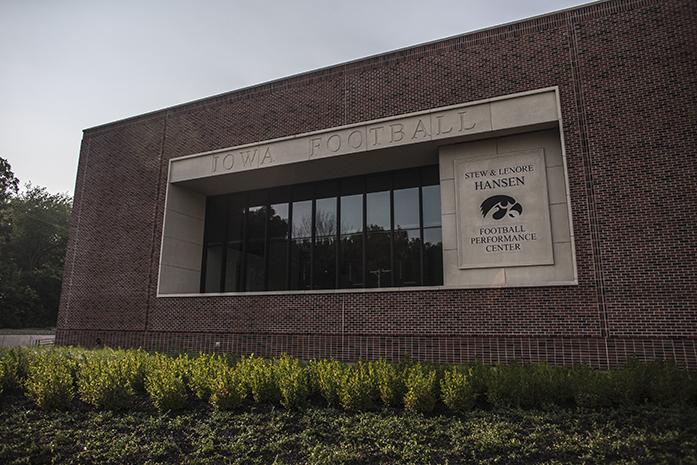Iowa’s expensive facility has all the features to build a solid future for Hawkeye football.
By Charlie Green
[email protected]
While approaching the Hansen Football Performance Center, the words “Iowa Football” loom large over the main entrance; above that sits an even larger Tigerhawk, spread across a set of windows made of specially pixelated glass. From that point on the inside the decal is invisible — what is seen instead is Kinnick Stadium.
“If you bring a 16- or 17-year-old recruit in here, and you stand them in here the day of a game, you imagine what that pageantry looks like out there on game day,” senior construction project manager Jeff Harney said. “How impressive that will be for them to be able to see.”
Part performance center, part monument to the glory of the program, the $55 million project is a sign that the Athletics Department is well invested in the football team’s future.
The question is: Can it boost recruiting?
It certainly can’t hurt.
“If you were to walk away from this, as we talk to all the guys that we’re recruiting, when you leave this facility, something is going to resonate with you as to, ‘Boy, that’s what Iowa is,’ ” recruiting coordinator Seth Wallace said. “And more than likely, when you leave here, it’s going to be the weight room.”
The weight room is just one of many features of the new facility, which broke ground in March 2013 and opened for football use following last season, but coaches will unanimously say it’s the foundation of Iowa football — and more than a solid foundation at that.
The 23,000 square-foot room is more than twice the size of its predecessor, complete with 32 power stations, a 75-yard strip of field turf, and a snack and smoothie bar for nutrition before and after workouts.
“We visited about 12 different facilities as we planned this facility,” strength and conditioning coordinator Chris Doyle said. “And the idea there was to learn what other people were doing, find the best of what’s out there, and combine it into a facility that would serve us and serve us the best.”
Doyle and the staff also made sure to include details that many might not think about — those integral to the flow and function of the facility as a whole that account for aspects such as delivery and distribution.
“An 18-wheeler can pull up undercover,” he said. “Open up a garage door, and you could actually drive a vehicle from that 18-wheeler right out to our practice field.
“There’s a central artery, a central hallway in which we can quickly distribute supplements, equipment, sports medicine supplies, right through that central artery on wheels.”
It’s a whole world of football in one building, with everything necessary for players to train and prepare in proximity. The sports-medicine room is across the hall from the weight room, in which physicians and trainers can rehab and treat injuries and monitor the mechanics of athletes as they train to ensure the safest environment possible. Upstairs contains position meeting rooms, offices, and classrooms for studying.
There’s even an area designated to feed the athletes as a team, called the “All-American Room,” which simultaneously honors past Hawkeye greats. There, the team enjoys catered meals from the Bread Garden Market, Iowa Chop House, and other local restaurants.
The whole building is designed to maximize the efficiency and convenience of players, staff, and the program a whole. With the indoor practice field adjacent to the weight room, and outdoor field adjacent to that, perhaps the longest walk the players make is across the parking lot on Saturday mornings.
The “Bowl Wall” features every bowl game the Hawkeyes have ever played in, with spaces to add plenty more. The wins include the score of the game, the losses leave that information to the imagination (or memory).
So maybe the better question is: When, not if, will the allure of this palace be felt in Iowa’s recruiting efforts?
It’s hard to tell at this point, but Iowa’s recruiting may be on the rise. Rivals.com ranks the 2016 class at No. 24, as the program’s 23 oral commits is the highest in the Football Bowl Subdivision. Fifteen of them are classified as three-star recruits.
It’s a long way until national signing day in January, but if it proceeds this way, it would be a stark improvement from the 58th ranked 2015 class — and its best since 2005.
There’s no way to predict how a highly ranked class will turn out, and many of the top-ranked recruits never make a name for themselves. But consistently high rankings do appear to coincide with program stability — that is, success over a period of time — something that has not characterized Iowa football in recent years.
For now, it’s too soon to know for sure. In the meantime, the facility helps the Hawkeyes keep pace with other top programs and gives Doyle and Company a stage to go about Iowa football the way they ‘ve come to know.
“There are a lot of schools that collect talent,” Doyle said. “We build it.”
Follow @CharlsGreen on Twitter for news, updates, and analysis on the Iowa football team.



